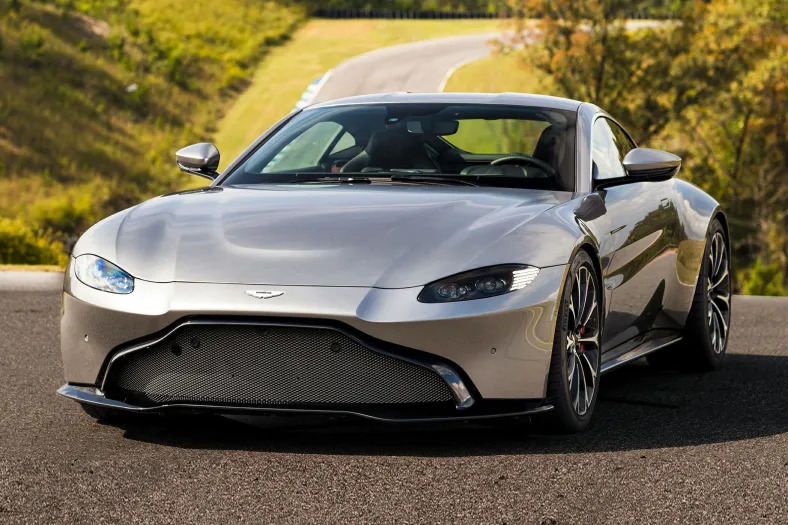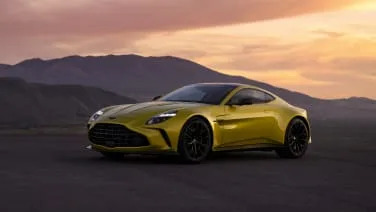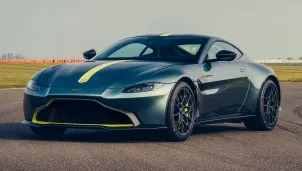2020 Aston Martin Vantage
Our roads may be virtually empty, with Americans all cooped up and nowhere to go. But with jet planes and TSA lines looking iffy and icky for the foreseeable future, the great American road trip is poised to reclaim its preeminence in travel. To test that post-pandemic theory, in a purely theoretical way, I requisition a 2020 Aston Martin Vantage for a daytrip from New York to the Catskills. It’s the kind of high-character “import” sports car that once defined the breed, before corporate imperatives watered the character down. Aston’s two-seater is nakedly beautiful, flawed-yet-fabulous, and expensive as hell. But if you drive the Vantage and don’t fall head-over-loafers, I’d accuse you of not caring for sports cars at all. It’s as alive and engaging as any sports car out there, a 509-horsepower firecracker that rewards skilled drivers – or dings them for mistakes – in defiance of the trend toward all-wheel-drive automatons. As for the Catskills, it’s in the midst of its own explosive comeback. This rough-hewn mountain region, a convenient two hours north of Manhattan, was once the prime vacation destination of the Northeast, so popular in the late 19th century that a 1,200-room luxury hotel was required just to gaze at some waterfalls, with guests including U.S. presidents and Oscar Wilde. Through the 1950s and 60s, it continued to be the pipeline to nature for Jewish families and other northeast tourists. Their summer camps and sprawling “Borscht Belt” resorts and nightclubs mythologized in films like Dirty Dancing and now television’s The Marvelous Mrs. Maisel, which has fetishized Catskills nostalgia to a truly marvelous degree. Then came airline travel, and affordable tickets to Miami Beach and other exotic warm-weather locales. Like a Palm Springs of the east, the Catskills fell into steep decline. The region became a punch line of corny kitsch. As with Palm Springs, fashion has come full circle: The Catskills and adjacent Hudson Valley are red-hot again, rediscovered by Brooklynites especially as a magical spot for affordable second homes, or permanent moves to open farm-to-table restaurants, curated antique shops and other bastions of rustic hip. The Vantage lures me from coronavirus lockdown like a movie idol waving outside my Brooklyn window, for a cannon-shot recon run to Woodstock. This wasn’t the new-for-2020 Vantage AMR that I first drove in Germany, with its lightened body, stiffened suspension and optional, dogleg-style manual transmission. But this standard Vantage was still alluring enough to draw my neighbors outdoors for some heavy breathing through their masks. The shark-mouthed, wide-hipped Vantage may go down as designer Marek Reichman’s brave masterpiece, the first Aston in ages that comes across as a truly new sports car; more than another Russian-doll replica of the DB7 (and its successors) that Reichman’s predecessor, Ian Callum, gifted the automotive world in 1993. Aston wrapped its aluminum-tubbed baby – its chassis 10% stiffer than the pricier DB11’s – with aluminum, steel and composite panels, for a svelte dry weight of 3,366 pounds. It goes down further with optional, weight-saving …
Full Review
Our roads may be virtually empty, with Americans all cooped up and nowhere to go. But with jet planes and TSA lines looking iffy and icky for the foreseeable future, the great American road trip is poised to reclaim its preeminence in travel. To test that post-pandemic theory, in a purely theoretical way, I requisition a 2020 Aston Martin Vantage for a daytrip from New York to the Catskills. It’s the kind of high-character “import” sports car that once defined the breed, before corporate imperatives watered the character down. Aston’s two-seater is nakedly beautiful, flawed-yet-fabulous, and expensive as hell. But if you drive the Vantage and don’t fall head-over-loafers, I’d accuse you of not caring for sports cars at all. It’s as alive and engaging as any sports car out there, a 509-horsepower firecracker that rewards skilled drivers – or dings them for mistakes – in defiance of the trend toward all-wheel-drive automatons. As for the Catskills, it’s in the midst of its own explosive comeback. This rough-hewn mountain region, a convenient two hours north of Manhattan, was once the prime vacation destination of the Northeast, so popular in the late 19th century that a 1,200-room luxury hotel was required just to gaze at some waterfalls, with guests including U.S. presidents and Oscar Wilde. Through the 1950s and 60s, it continued to be the pipeline to nature for Jewish families and other northeast tourists. Their summer camps and sprawling “Borscht Belt” resorts and nightclubs mythologized in films like Dirty Dancing and now television’s The Marvelous Mrs. Maisel, which has fetishized Catskills nostalgia to a truly marvelous degree. Then came airline travel, and affordable tickets to Miami Beach and other exotic warm-weather locales. Like a Palm Springs of the east, the Catskills fell into steep decline. The region became a punch line of corny kitsch. As with Palm Springs, fashion has come full circle: The Catskills and adjacent Hudson Valley are red-hot again, rediscovered by Brooklynites especially as a magical spot for affordable second homes, or permanent moves to open farm-to-table restaurants, curated antique shops and other bastions of rustic hip. The Vantage lures me from coronavirus lockdown like a movie idol waving outside my Brooklyn window, for a cannon-shot recon run to Woodstock. This wasn’t the new-for-2020 Vantage AMR that I first drove in Germany, with its lightened body, stiffened suspension and optional, dogleg-style manual transmission. But this standard Vantage was still alluring enough to draw my neighbors outdoors for some heavy breathing through their masks. The shark-mouthed, wide-hipped Vantage may go down as designer Marek Reichman’s brave masterpiece, the first Aston in ages that comes across as a truly new sports car; more than another Russian-doll replica of the DB7 (and its successors) that Reichman’s predecessor, Ian Callum, gifted the automotive world in 1993. Aston wrapped its aluminum-tubbed baby – its chassis 10% stiffer than the pricier DB11’s – with aluminum, steel and composite panels, for a svelte dry weight of 3,366 pounds. It goes down further with optional, weight-saving …
Hide Full Review
Hide Full Review
Retail Price
$152,995 - $204,995
MSRP / Window Sticker Price
| Engine | 4.0L V-8 |
| MPG | Up to 18 city / 24 highway |
| Seating | 2 Passengers |
| Transmission | 7-spd man w/OD, 8-spd auto w/OD |
| Power | 503 @ 6000 rpm |
| Drivetrain | rear-wheel |
Smart Buy Program is powered by 






